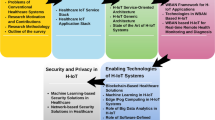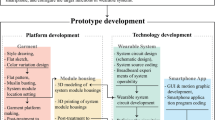Abstract
The amount of information available for a person at a given time is growing at a disproportioned rate. Moreover, smart devices are becoming more and more popular. To avoid that human’s attention becomes a bottleneck and improve the number of notifications delivered to users, we believe that smart devices could serve as notifications mechanisms. This paper summarizes and concludes the efforts of a research project focusing on the use of smart devices as notification mechanisms. The goal of the framework is to assist researchers and developers in the conceptualization of smart device-based notifications. Furthermore, this paper presents the results of three evaluations. First, it describes the results of a survey on the need for novel notification mechanisms and the utility of smart devices as notification delivery mechanisms. Second, the results of a quantitative assessment on the impact of notifications delivered through smart devices compared with notifications delivered through smartphones. Results show that smart devices are useful to deliver valuable information and the quantitative assessment discovered that there is no significant difference between smart devices and smartphones delivering notifications. Finally, the applicability of the framework was evaluated and considered useful by software developers.









Similar content being viewed by others
References
Arroyo E, Selker T (2011) Attention and intention goals can mediate disruption in human-computer interaction. In: Campos P, Graham N, Jorge J, et al. (eds) Human-computer interaction—INTERACT 2011. Springer, Berlin, pp 454–470
Baer D (2014) Dwight Eisenhower nailed a major insight about productivity. In: Bus. Insid. https://www.businessinsider.com/dwight-eisenhower-nailed-a-major-insight-about-productivity-2014-4. Accessed 13 May 2019
Berry B (2003) Adapting heuristics for notification systems. In: ACM southeast conference. ACM, pp 144–149
Bogunovich P, Salvucci D (2011) The effects of time constraints on user behavior for deferrable interruptions. In: Proceedings of the SIGCHI conference on human factors in computing systems. ACM, New York, pp 3123–3126
Böhmer M, Lander C, Gehring S et al (2014) Interrupted by a phone call: exploring designs for lowering the impact of call notifications for smartphone users. In: Proceedings of the 32nd annual ACM conference on human factors in computing systems. ACM, New York, pp 3045–3054
Bravo J, Fuentes L, de Ipiña DL (2011) Theme issue: “ubiquitous computing and ambient intelligence”. Pers Ubiquitous Comput 15:315–316. https://doi.org/10.1007/s00779-010-0358-9
Brenes JA, López G, Guerrero LA (2017) Development and evaluation of augmented object prototypes for notifications in collaborative writing environments. In: Nunes IL (ed) Advances in human factors and system interactions. Springer International Publishing, Cham, pp 301–312
Cohen MA, Horowitz TS, Wolfe JM (2009) Auditory recognition memory is inferior to visual recognition memory. Proc Natl Acad Sci 106:6008–6010. https://doi.org/10.1073/pnas.0811884106
Gluck J, Bunt A, McGrenere J (2007) Matching attentional draw with utility in interruption. In: Proceedings of the SIGCHI conference on human factors in computing systems. ACM, New York, pp 41–50
Guzman M, López G, Guerrero LA (2018) Human factors affecting the development of smart device-based notifications. In: Nunes IL (ed) Advances in human factors and systems interaction. AHFE 2017. Advances in intelligent systems and computing. Springer, Cham, pp 251–259
Hart G (1996) The five W’s: an old tool for the new task of audience analysis. Tech Commun 43:137–145
Hinderks A, Schrepp M, Thomaschewski J (2018) User Experience Questionnaire (UEQ). https://www.ueq-online.org/. Accessed 8 May 2019
IFTTT Inc (2019) IFTTT: a world that works for you. https://ifttt.com/. Accessed 19 Apr 2019
Iqbal ST, Bailey BP (2010) Oasis: a framework for linking notification delivery to the perceptual structure of goal-directed tasks. ACM Trans Comput Interact 17:1–28. https://doi.org/10.1145/1879831.1879833
Laugwitz B, Held T, Schrepp M (2008) Construction and evaluation of a user experience questionnaire. In: HCI and usability for education and work, pp 63–76
López G, Guerrero LA (2017) Awareness supporting technologies used in collaborative systems: a systematic literature review. Conference on computer supported cooperative work and social computing. ACM, New York, pp 808–820
López G, González I, Jimenez-Garcia E et al (2018) Smart device-based notifications to promote healthy behavior related to childhood obesity and overweight. Sensors 18:271. https://doi.org/10.3390/s18010271
Mark GJ, Voida S, Cardello A V (2012) “A pace not dictated by electrons”: an empirical study of work without email. In: Proceedings of the SIGCHI conference on human factors in computing systems. ACM, New York, pp 555–564
McCrickard DS, Czerwinski M, Bartram L (2003) Introduction: design and evaluation of notification user interfaces. Int J Hum Comput Stud 58:509–514
McFarlane DC, Latorella KA (2002) The scope and importance of human interruption in human-computer interaction design. Hum Comput Interact 17:1–61. https://doi.org/10.1207/S15327051HCI1701_1
Norman D, Miyata Y (1986) Psychological issues in support of multiple activities. In: User centered systems design: new perspectives on human-computer interaction. Lawrence Erlbaum Associates, pp 265–284
OASIS (2020) MQTT. https://mqtt.org/. Accessed 7 Jan 2020
Okoshi T, Nakazawa J, Tokuda H (2016) Interruptibility research: opportunities for future flourishment. In: ACM international joint conference on pervasive and ubiquitous computing: adjunct. ACM, New York, pp 1524–1529
Oxford Dictionaries (2010) Oxford Dictionary of English. Oxford University Press, Oxford
Paul CL (2013) A model of contextual factors and their effects in the interruptive notification user experience. Dissertation, University of Maryland
Pejovic V, Musolesi M (2014) InterruptMe: designing intelligent prompting mechanisms for pervasive applications. In: Proceedings of the 2014 ACM international joint conference on pervasive and ubiquitous computing. ACM, New York, pp 897–908
Pielot M, Rello L (2015) The do not disturb challenge: a day without notifications. In: Proceedings of the 33rd annual ACM conference extended abstracts on human factors in computing systems. ACM, New York, pp 1761–1766
Trafton JG, Monk CA (2007) Task interruptions. Rev Hum Factors Ergon 3:111–126. https://doi.org/10.1518/155723408X299852
Voit A, Poppinga B, Weber D et al (2016) UbiTtention: smart & ambient notification and attention management. In: Proceedings of the 2016 ACM international joint conference on pervasive and ubiquitous computing adjunct—ubicomp ’16. ACM Press, New York, pp 1520–1523
Weber D, Shirazi AS, Henze N (2015) Towards smart notifications using research in the large. In: International conference on human-computer interaction with mobile devices and services adjunct. ACM, New York, pp 1117–1122
Yoong S, López G, Guerrero LA (2018) Smart device-based notifications: a survey on user’s satisfaction of traditional notification mechanisms. In: Ho AG (ed) Advances in communication of design. Springer, Cham, pp 104–114
Acknowledgements
The Research Center for Communication and Information Technologies (CITIC) at the University of Costa Rica supported this work. This work was also supported by MICITT and by CONICIT of the Government of Costa Rica.
Author information
Authors and Affiliations
Corresponding author
Additional information
Publisher's Note
Springer Nature remains neutral with regard to jurisdictional claims in published maps and institutional affiliations.
Rights and permissions
About this article
Cite this article
López, G., Guerrero, L.A. A conceptual framework for smart device-based notifications. J Ambient Intell Human Comput 13, 5433–5445 (2022). https://doi.org/10.1007/s12652-020-01801-w
Received:
Accepted:
Published:
Issue Date:
DOI: https://doi.org/10.1007/s12652-020-01801-w




